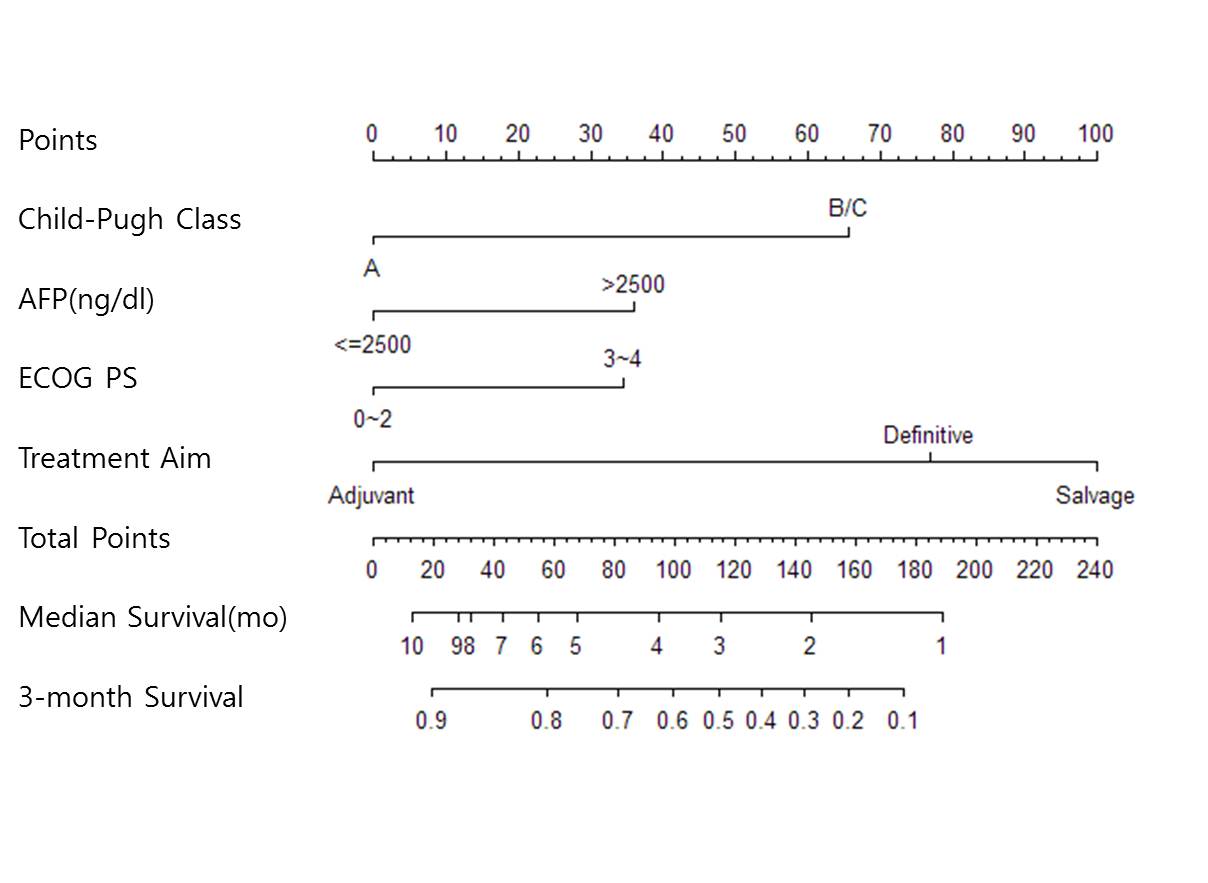글로벌 연구동향
방사선종양학
- [J Neurooncol] Nomogram prediction of survival in patients with brain metastases from hepatocellular carcinoma treated with whole-brain radiotherapy: a multicenter retrospective study.
서울의대 / 김규보*
- 출처
- J Neurooncol.
- 등재일
- 2015 Nov
- 저널이슈번호
- 125(2):377-83. doi: 10.1007/s11060-015-1926-7. Epub 2015 Sep 5.
- 내용

Abstract
The incidence of brain metastasis from hepatocellular carcinoma (HCC) is increasing because of the improved survival outcome of HCC patients, but the prognosis of these patients is extremely poor. HCC patients with brain metastasis were investigated to identify their prognostic factors for overall survival. Patients with brain metastasis from HCC who had been treated with whole-brain radiotherapy (WBRT) in five hospitals were enrolled in the study. The medical records of the patients were reviewed, and the clinical factors were analyzed to identify the prognostic factors for overall survival. Of the total of 97 patients who were enrolled in the study, 83 were male and the median age at the brain metastases was 56.6 years. Motor weakness (43.3 %) and headache (41.2 %) were common presenting symptoms. The median AFP level was 4180 ng/ml, and 81 patients were assessed as belonging to Child-Pugh classification A upon the diagnosis of brain metastasis. WBRT alone in 71 patients, surgery or radiosurgery combined with WBRT as the adjuvant setting in 18 patients, and WBRT as salvage treatment in 8 patients were performed. The median overall survival of the patients was 3.5 months. In the multivariate analysis, the ECOG performance status (PS), Child-Pugh classification, AFP, and treatment aim showed significant association with the overall survival of the patients. Based on these factors, a nomogram predicting the prognosis was developed. The concordance index of the nomogram was 0.74, and the prediction was well calibrated. In conclusion, the survival outcome of patients with brain metastasis from HCC can be predicted with the nomogram constructed from the ECOG PS, Child-Pugh classification, AFP, and treatment aim.Author information
Park Y1,2, Kim KS2, Kim K3, Chie EK2, Kim JH2, Kim JS4, Kim TH5, Kim DY5, Jang WI6, Kim MS6, Koo TR1, Chang AR1.
1Department of Radiation Oncology, Soonchunhyang University Seoul Hospital, Seoul, Republic of Korea.
2Department of Radiation Oncology, Seoul National University College of Medicine, 101 Daehak-ro, Jongno-gu, Seoul, 110-744, Republic of Korea.
3Department of Radiation Oncology, Seoul National University College of Medicine, 101 Daehak-ro, Jongno-gu, Seoul, 110-744, Republic of Korea. kyubokim@snu.ac.kr.
4Department of Radiation Oncology, Seoul National University College of Medicine, Seoul National University Bundang Hospital, Seongnam, Republic of Korea.
5Center for Proton Therapy, Research Institute and Hospital, National Cancer Center, Goyang, Republic of Korea.
6Department of Radiation Oncology, Korea Institute of Radiological & Medical Sciences, Seoul, Republic of Korea.
- 키워드
- Brain metastasis; Hepatocellular carcinoma; Nomogram; Prognostic factor
- 연구소개
- 국내 5개 병원에서 간암의 뇌전이로 전뇌방사선치료를 받은 환자들의 치료성적을 분석하였고, 이를 바탕으로 기대여명을 예측하는 노모그램을 개발한 논문입니다. 노모그램은 전뇌방사선치료 당시의 수행능력, 간기능, 종양표지자, 전뇌방사선치료의 목적 등 4개의 인자로 구성되어 있습니다. 이러한 인자들 중 대부분은 기존의 연구에서도 간암 환자의 예후를 예측하는 것으로 보고된 바 있지만, 노모그램을 통해서 각 환자의 기대여명을 예측할 수 있다는 점에서 장점이 있겠습니다.
- 덧글달기
- 이전글 [Int J Radiat Oncol Biol Phys] Concurrent Chemoradiation Therapy Followed by Consolidation Chemotherapy for Localized Extranodal Natural Killer/T-Cell Lymphoma, Nasal Type.
- 다음글 [Radiother Oncol] Effects of adjuvant radiotherapy on completely resected gastric cancer: A radiation oncologist's view of the ARTIST randomized phase III trial.









